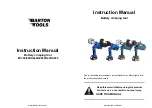
Jabiru Aircraft
Pilot Operating Handbook
Model J230-D
Revision:
6
28/2/2020
Page 28
3.3.5
Other Emergencies
In some of the cases described below there is more than 1 potential cause for a given situation.
For example, if the oil pressure gauge indicates zero, it may be due to a failure of the gauge or
sender instead of an actual problem with the engine.
The procedures given below in all cases assume that the indications given are true and correct.
It is important to remain calm and think as clearly as possible. Again: The following
basic rules
apply to
all
aircraft emergencies:
1.
Maintain
Aircraft Control.
2.
Analyse
the situation before taking appropriate action.
Don’t act without thinking.
3.
Land
as soon as practicable.
Loss of Oil Pressure
1.
Airspeed ............................................................ 65 KIAS
2.
Power ................................................................ IDLE
3.
Precautionary landing ........................................ AS SOON AS PRACTICAL
High Oil Pressure
1.
RPM .................................................................. REDUCE UNTIL PRESSURE DROPS
2.
Precautionary landing ........................................ AS SOON AS PRACTICAL
Emergency Descent
– Type 1
1.
Power ................................................................ IDLE
2.
Carburettor Heat ................................................ ON
3.
Airspeed ............................................................ 120+ KIAS (less than V
NE
)
4.
Flaps ................................................................. UP
NOTE
This descent gives high vertical speeds but may make controlling the aircraft difficult when
passing through narrow holes in clouds etc. Type 1 descents are for clear, smooth air only.
Emergency Descent
– Type 2
1.
Power ................................................................ IDLE
2.
Carburettor Heat ................................................ ON
3.
Airspeed ............................................................ 84 KIAS (V
FE
)
4.
Flaps ................................................................. FULL DOWN
NOTE
This type of descent gives high vertical speeds while minimising loads on the aircraft structure
and improving controllability around obstacles (such as cloud etc).
S-Turns or Side slips may be used to increase descent rate; see Section 4.10
















































